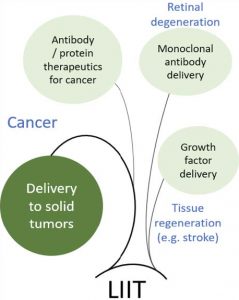LIIT: Local Infusion of Immuno-Therapeutics
Hydrogels for local and LONG-TERM release of biologics

Tech ID
17-002
Inventors
R. Wylie
V. Hyunh
Patent Status
US Patent 10,576,61
CA patent application filed
Stage of Research
Proof of principle data available
Planned pre-clinical studies in tumor model
Contact
Amy Hector
Business Development Manager
Abstract
Protein and antibody therapeutics are becoming an increasingly prevalent class of drugs due to their selectivity and potency compared to small molecule drugs. However, administration and delivery are challenging due to their pharmacokinetic properties such as uptake at disease sites, half-life, tissue distribution, elimination. Currently, repeated and frequent intravenous doses or infusions are required to achieve therapeutic benefit. For example, bispecifics are continually infused for several weeks. Therefore, there is a need for improved methods of delivery for these protein and antibody therapeutics.
Hydrogels are an ideal vehicle for drug delivery since they are injectable, biocompatible and hold large drug payloads with enhanced protein stability. Currently, their use clinically has been limited because they only marginally decrease injection frequency. Researchers at McMaster have developed a platform technology with hydrogels that can sustain and localize antibody/protein release for several weeks. Ongoing work with this platform technology includes pre-clinical mouse studies in a glioblastoma model.
Applications
- Any treatment requiring local and long-term delivery of a macromolecule (e.g. antibody, bispecific, protein), for example, retinal degenerative diseases, pain medication, cancer therapeutics
Advantages
- Hydrogels drug release mechanism prevents drug loss from injection site, ensuring proper dose of drug is administered and concentration is maintained for longer periods of time, leading to extended therapeutic benefit
- Reduced injection frequency, thereby increasing patient compliance, lowering healthcare costs and minimizing risk of infections and systemic side effects
- Local injections concentrate drugs at disease sites, thereby reducing adverse events experienced with systemic delivery of drugs
- Point source of drug infusion is optimally placed within the body

